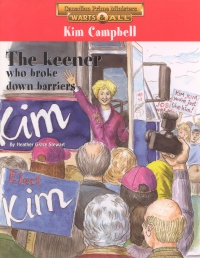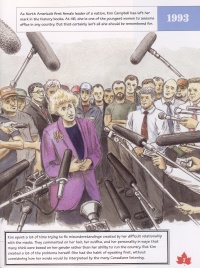| ________________
CM . . .
. Volume XV Number 10. . . .January 9, 2009 
 |
Kim Campbell: The Keener Who Broke Down Barriers. (Canadian Prime Ministers: Warts & All).
Heather Grace Stewart. Illustrated by Thomas Dannenberg.
Toronto, ON: JackFruit Press, 2007.
57 pp., pbk., $19.95.
ISBN 978-0-9736407-0-0.
Subject Headings:
Campbell, Kim, 1947- -Juvenile literature.
Canada-Politics and government-1993-2003-Juvenile literature.
Prime ministers-Canada-Biography-Juvenile literature.
Grades 4-8 / Ages 9-13.
Review by Julie Chychota.
*** /4
|
| |
|

excerpt:
Over the summer, Kim received the highest approval rating for a prime minister in 30 years. The media seemed to be giving her a fresh start. Canadians saw her as a welcome change.
During her four months as prime minister, Kim had one major achievement: a massive reorganization of government departments, the most radical reorganization since Confederation. She created the Department of Canadian Heritage and the Department of Human Resources. She expanded, renamed, and amalgamated several other departments. She also downsized her cabinet to twenty-five people. This downsizing proved to be a popular move with most Canadians who appreciated that Kim was living up to her leadership campaign promises.
Heather Grace Stewart has written a smart, sympathetic account of Canada's nineteenth Prime Minister, The Right Honourable Kim Campbell. In seven chapters, the author takes readers from the 1947 birth of Avril Phaedra Douglas Campbell in Port Alberni, BC, through her formative years and rebirth as "Kim," to her emergence as leader of the Progressive Conservatives and Canada's first female prime minister in 1993. From there, the text follows Campbell to her present incarnation as lecturer and advocate for democracy. Although she was Prime Minister only a short time, the epilogue suggests Kim Campbell's story has less to do with the destination than the journey to and from it.
Kim Campbell: The Keener Who Broke Down Barriers shares formal and stylistic elements of previous releases in Jackfruit Press's "Canadian Prime Ministers: Warts & All" series. For instance, all of the books in the series refer to their subjects by their first names and discuss their weaknesses as well as their strengths, tactics that, along with a conversational tone, make the former leaders more accessible to young readers. Stewart's contribution likewise applauds the great strides Campbell made, even as it acknowledges that she made her share of missteps. Yet it is precisely that fallibility with which readers can identify.
To further engage the intended readership, a cartoon beaver sporting a red ball cap and t-shirt emblazoned with a red maple leaf appears in sidebars. He offers a running commentary and directly quotes Campbell on a number of occasions. Presumably, the beaver also provides a visual continuity that spans the series, since nine different illustrators have worked on the 13 biographies to date. Readers of other titles in the series will recognize the page numbers set in maple leaves as well as the blue sidebars with chronological notes on the initial page of each chapter. The haphazardness of the font used for the table of contents and for chapter subheadings reinforces the notion of including "warts and all."
 Possessing the same dimensions as the other volumes, Stewart's measures 28 cm x 22 cm. These generous proportions are all the better to showcase Thomas Dannenberg's colored illustrations, which have the delicate appearance of pencil and/or watercolor. Of the 57 pages in total, 17 depict moments in Campbell's life, effectively paraphrasing in images the events that Stewart fixes in words (although captions pulled from the text do accompany the pictures). In contrast, the lone photograph occurs on the title page and captures a smiling Campbell at the unveiling of her prime ministerial portrait. The drawings mark, better than photography in its immediacy could, that this book represents an interpretation of Campbell, that is, a particular way of seeing her.
Possessing the same dimensions as the other volumes, Stewart's measures 28 cm x 22 cm. These generous proportions are all the better to showcase Thomas Dannenberg's colored illustrations, which have the delicate appearance of pencil and/or watercolor. Of the 57 pages in total, 17 depict moments in Campbell's life, effectively paraphrasing in images the events that Stewart fixes in words (although captions pulled from the text do accompany the pictures). In contrast, the lone photograph occurs on the title page and captures a smiling Campbell at the unveiling of her prime ministerial portrait. The drawings mark, better than photography in its immediacy could, that this book represents an interpretation of Campbell, that is, a particular way of seeing her.
While illustrations make up almost a third of the text, approximately one-quarter of it consists of additional features, namely, five "Hot Topics" pages, a four-page timeline, a glossary, an index, and a list of resources for further exploration. "Hot Topics" are odd-numbered pages with buttercream backgrounds inserted at regular intervals throughout. They contextualize some of the burning issues of Campbell's day, such as gun control and spin-doctoring, drawing parallels to similar issues in Canada and the United States before and after Campbell's term in power.
The back matter begins with the timeline, a handy grid that sets key moments in Campbell's life side-by-side with concurrent national and global events. Following that, the glossary defines and explains the names and expressions that appear in boldface within the text, positions like "consul general," concepts such as "democracy," and individuals, for example, "Charest, Jean" and "Friedan, Betty." The index is tidily laid out in three columns while the list of resources is a mash-up comprising Campbell's autobiography, an NFB documentary, the Library and Archives Canada and CBC Websites, and entries for a historical landmark and Campbell's official portrait in the House of Commons.
Three main themes run through Kim Campbell: The Keener Who Broke Down Barriers. First is the notion of the "keener," the young overachiever who forges a name for herself, both literally and figuratively. The book tells us of the adolescent Avril's decision to be known as Kim, a name her estranged mother had favored until a friend chose it for her son (p. 10). Whether or not the name empowered Campbell due to its association with her mother or its gender neutrality, it was shortly after her adoption of it that she began to forge a political identity for herself. Campbell became her high school's "first female student council president" (p.10), the first in a chain of firsts, as Stewart proceeds to detail.
The second theme concerns Campbell's style of leadership. In the introduction, Stewart asks the rhetorical question, "What was Kim Campbell's recipe for becoming prime minister?" (p. 5). With this trope that mixes cuisine with politics, the book early on hints at what it later explicitly confirms (p. 15): Campbell espoused a feminist philosophy which she brought to bear upon a traditionally masculine domain. The assumption underlying the remainder of the book is that feminism informed Campbell's advocacy for the disenfranchised—First Nations, people with AIDS (p. 22), people with disabilities, and homosexuals (p. 30)—and her self-described "politics of inclusion" which favored input from "ordinary citizens" (p. 30). In this way, the text implies, Campbell "broke down barriers" not only for herself, but also for many marginalized Canadians.
A third theme Stewart explores is the relationship between the media and politicians, particularly female politicians. The book begins by marking Campbell's reportage for the CBC's Junior Television Club at the age of 10 (p. 9); it comes full circle by its conclusion which mentions that Campbell turned radio show host and interviewer in 1995-1996 (p. 43-44). In fact, although the primary text omits mention of it, the timeline notes that Campbell served on a panel of judges for the TV show, Canada''s Next Great Prime Minister in 2007 (p. 51). As it traces her progress through municipal, provincial, and federal politics, the text questions whether, as a woman, Campbell was subject to closer scrutiny than her male counterparts. Readers are given reason to believe the answer is a resounding "yes."
There are a few glitches in Stewart's book. First, it identifies Campbell as "North America's first female leader of a nation" (p. 6), when Internet searches suggest that she was the third after Eugenia Charles, prime minister of Dominica from 1980 to 1995, and Violeta Barrios de Chamorro, president of Nicaragua from 1990 to 1996. Campbell still lays claim to an impressive number of firsts within Canada: "first female minister of justice and attorney general, first female minister of national defence, first woman elected as leader of the Progressive Conservative party, first female Canadian prime minister and first prime minister, [sic] from British Columbia" (p. 46). Additionally, a handful of grammatical and typographical errors and omissions creep in, mainly in the glossary (e.g., a phrase that should read "of what is now Ontario" replaces the "w" in "what" with an "s"). These little hitches, however, won't detract from the purpose of this book or of the series, which aims to make history relevant to today's kids.
Jackfruit Press's three-pronged mission statement is to engage, inspire, and educate children—"because knowledge is power" its slogan asserts (www.jackfruitpress.com). Since its subject is a woman and its slant is feminist, Stewart's book may engage and inspire girls more often than boys. In fact, one of the concluding sentences quotes Campbell as taking pride "in having 'changed the sense of what is possible for many young woman and girls in Canada'" (p. 47). Nevertheless, Kim Campbell: The Keener Who Broke Down Barriers should educate both sexes equally about the challenges inherent in a political career.
Recommended.
Julie Chychota lives in Ottawa, ON, but has never met the prime minister; she did, however, meet the MP for Winnipeg South at a recent University of Manitoba Alumni Association event.

To comment
on this title or this review, send mail to cm@umanitoba.ca.
Copyright © the Manitoba Library Association. Reproduction for personal
use is permitted only if this copyright notice is maintained. Any
other reproduction is prohibited without permission.
NEXT REVIEW |
TABLE OF CONTENTS FOR THIS ISSUE
- January 9, 2009.
AUTHORS |
TITLES |
MEDIA REVIEWS |
PROFILES |
BACK ISSUES |
SEARCH |
CMARCHIVE |
HOME |

 Possessing the same dimensions as the other volumes, Stewart's measures 28 cm x 22 cm. These generous proportions are all the better to showcase Thomas Dannenberg's colored illustrations, which have the delicate appearance of pencil and/or watercolor. Of the 57 pages in total, 17 depict moments in Campbell's life, effectively paraphrasing in images the events that Stewart fixes in words (although captions pulled from the text do accompany the pictures). In contrast, the lone photograph occurs on the title page and captures a smiling Campbell at the unveiling of her prime ministerial portrait. The drawings mark, better than photography in its immediacy could, that this book represents an interpretation of Campbell, that is, a particular way of seeing her.
Possessing the same dimensions as the other volumes, Stewart's measures 28 cm x 22 cm. These generous proportions are all the better to showcase Thomas Dannenberg's colored illustrations, which have the delicate appearance of pencil and/or watercolor. Of the 57 pages in total, 17 depict moments in Campbell's life, effectively paraphrasing in images the events that Stewart fixes in words (although captions pulled from the text do accompany the pictures). In contrast, the lone photograph occurs on the title page and captures a smiling Campbell at the unveiling of her prime ministerial portrait. The drawings mark, better than photography in its immediacy could, that this book represents an interpretation of Campbell, that is, a particular way of seeing her.